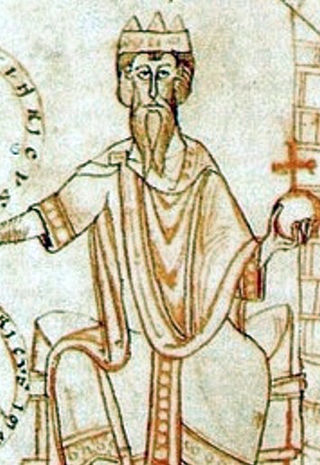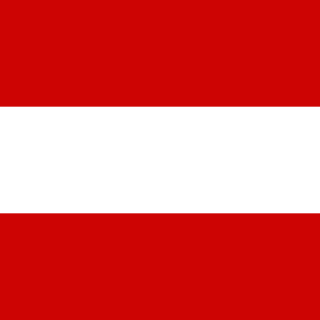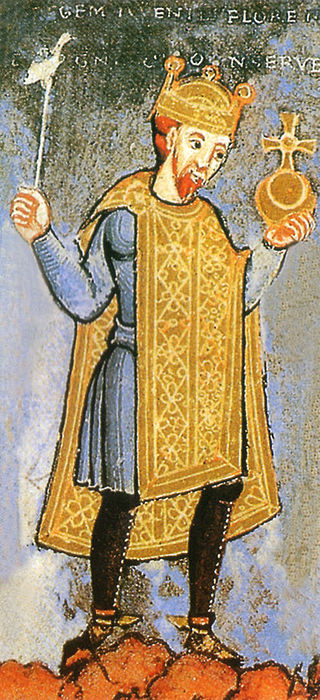Related Research Articles

Year 1037 (MXXXVII) was a common year starting on Saturday of the Julian calendar.

Conrad II, also known as Conrad the Elder and Conrad the Salic, was the emperor of the Holy Roman Empire from 1027 until his death in 1039. The first of a succession of four Salian emperors, who reigned for one century until 1125, Conrad ruled the kingdoms of Germany, Italy and Burgundy.

Lotharingia was a medieval successor kingdom of the Carolingian Empire. It comprised present-day Lorraine (France), Luxembourg, Saarland (Germany), Netherlands, most of Belgium, and Germany west of the Rhine. It was named after King Lothair II, who received this territory as his share of the Kingdom of Middle Francia which his father, Lothair I, had held.

Rudolph III, called the Idle or the Pious, was the king of Burgundy from 993 until his death. He was the last ruler of an independent Kingdom of Burgundy, and the last legitimate male member of the Burgundian line of the Elder House of Welf.

Godfrey I, called the Bearded, the Courageous, or the Great, was the Landgrave of Brabant, Count of Brussels and Leuven (Louvain) from 1095 to his death and Duke of Lower Lorraine from 1106 to 1129. He was also Margrave of Antwerp from 1106 to his death.

Gothelo, called the Great, was the duke of Lower Lorraine from 1023 and of Upper Lorraine from 1033. He was also the margrave of Antwerp from 1005 and count of Verdun. Gothelo was the youngest son of Godfrey I, Count of Verdun, and Matilda, daughter of Herman, Duke of Saxony. On his father's death, he received the march of Antwerp and became a vassal of his brother, Godfrey II, who became duke of Lower Lorraine in 1012. Gothelo succeeded his brother in 1023 with the support of the Emperor Henry II, but was opposed until Conrad II forced the rebels to submit in 1025. When the House of Bar, which ruled in Upper Lorraine, became extinct in 1033, with the death of his cousin Frederick II, Conrad made Gothelo duke of both duchies, so that he could assist in the defence of the territory against Odo II, count of Blois, Meaux, Chartres and Troyes. It was during this time 1033-1034, that Gothelo clashed with Baldwin IV, Count of Flanders, concerning the march of Ename.

The Duchy of Lower Lotharingia, also called Northern Lotharingia, Lower Lorraine or Northern Lorraine, was a stem duchy established in 959, of the medieval Kingdom of Germany, which encompassed almost all of modern Belgium, Luxemburg, the northern part of the German Rhineland province and the eastern parts of France's Nord-Pas de Calais region, it also include almost all of modern Netherlands.

Odo II was the count of Blois, Chartres, Châteaudun, Champagne, Beauvais and Tours from 1004 and count of Troyes and Meaux from 1022. He twice tried to make himself a king: first in Italy after 1024 and then in Burgundy after 1032.

The Kingdom of Upper Burgundy was a Frankish dominion established in 888 by the Welf king Rudolph I of Burgundy within the territory of former Middle Francia. It grew out of the Carolingian margraviate of Transjurane Burgundy southeast of the Jura Mountains together with the adjacent County of Burgundy (Franche-Comté) in the northwest. The adjective 'upper' refers to its location upstream in the Rhône river valley, as distinct from Lower Burgundy and also from the Duchy of Burgundy west of the Saône river. Upper Burgundy reunited with the Kingdom of Lower Burgundy in 933 to form the Kingdom of Burgundy, later known as Kingdom of Arles or Arelat.

Boniface III, son of Tedald of Canossa and the father of Matilda of Tuscany, was the most powerful north Italian prince of his age. By inheritance he was count of Brescia, Canossa, Ferrara, Florence, Lucca, Mantua, Modena, Pisa, Pistoia, Parma, Reggio, and Verona from 1007 and, by appointment, margrave of Tuscany from 1027 until his assassination in 1052.
The House of Ardenne–Verdun was a branch of the House of Ardenne, one of the first documented medieval European noble families, centered on Verdun. The family dominated in the Duchy of Lotharingia (Lorraine) in the 10th and 11th centuries. All members descended from Cunigunda of France, a granddaughter of the West Frankish king Louis the Stammerer. She married twice but all or most of her children were children of her first husband, Count Palatine Wigeric of Lotharingia. The other main branches of the House of Ardennes were the House of Ardenne–Luxembourg, and the House of Ardenne–Bar.

Henry III, called the Black or the Pious, was Holy Roman Emperor from 1046 until his death in 1056. A member of the Salian dynasty, he was the eldest son of Conrad II and Gisela of Swabia.

Conrad Schetz de Grobbendonck, later Conrad d'Ursel (1553–1632) was a nobleman in the Habsburg Netherlands and in 1604–1609 the first ordinary ambassador to England for the Archdukes Albert and Isabella.

Albert III was the Count of Namur from 1063 until his death. He was the son of Count Albert II and Regelinde of Verdun.
Albert II of Namur was Count of Namur from the death of his elder brother Robert II to his death in 1067. They were the sons of Albert I, and Ermengarde, daughter of duke Charles of Lower Lorraine.
Robert II of Namur was count of Namur from the death of his father in 1011 to some time between 1018 and 1031. He was the son of Albert I, and Ermengarde, daughter of Charles, Duke of Lower Lorraine.

Adalbero I was the bishop of Metz from 929 till 954.
Reginard was bishop of Liège in the Low Countries from 1025 to 1037, and had the city's first stone bridge over the Meuse built, the Pont des Arches.
Conrad-Albert-Charles d'Ursel, 1st Duke d'Ursel and Hoboken was a Dutch nobleman and general.
References
- 1 2 3 Léonce Lex, Eudes, comte de Blois (Troyes, Dufour-Bouquot, 1892), pp. 47-54. On Google Books
- ↑ Godefroid Kurth, "Réginard", Biographie Nationale de Belgique , vol. 18 (Brussels, 1905), 855-861.
- ↑ Jules Borgnet, "Albert II", Biographie Nationale de Belgique , vol. 1 (Brussels, 1866), 196–197.